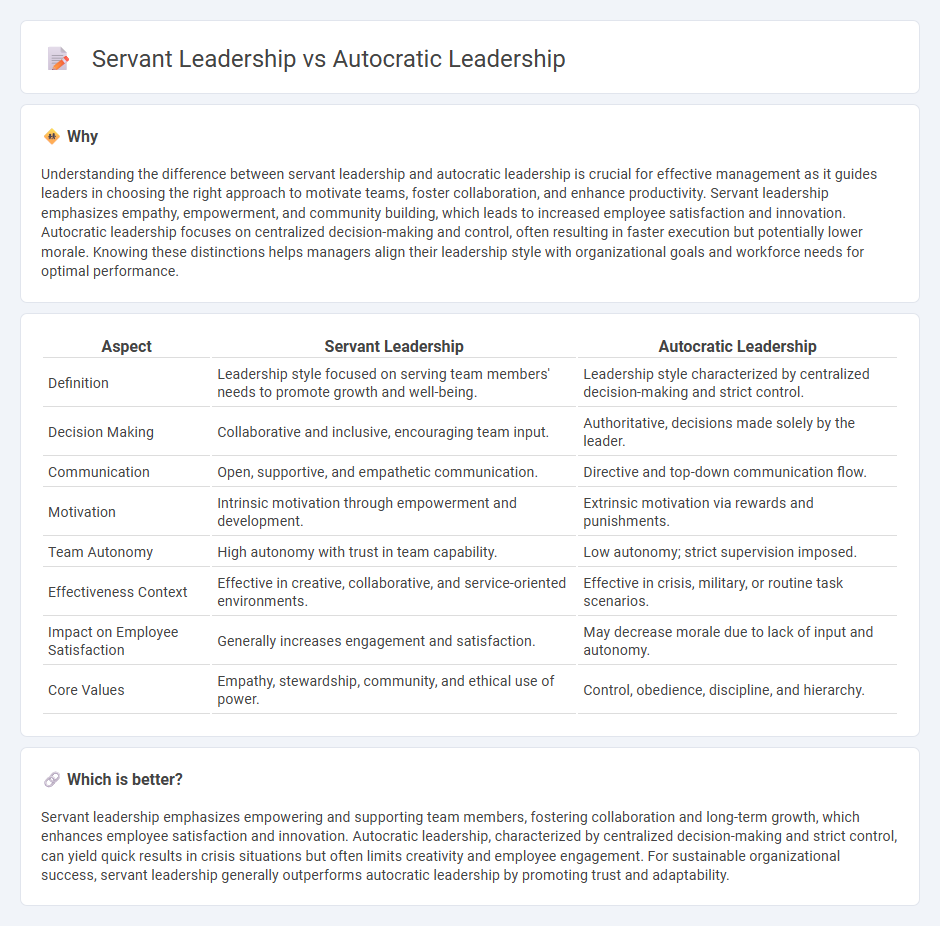
Servant leadership emphasizes prioritizing employees' needs, fostering collaboration, and empowering teams to achieve collective success, while autocratic leadership relies on centralized decision-making and strict control to drive organizational goals. This contrast highlights the impact of leadership style on employee motivation, productivity, and company culture. Explore the key differences and benefits of each approach to determine the best fit for your management strategy.
Why it is important
Understanding the difference between servant leadership and autocratic leadership is crucial for effective management as it guides leaders in choosing the right approach to motivate teams, foster collaboration, and enhance productivity. Servant leadership emphasizes empathy, empowerment, and community building, which leads to increased employee satisfaction and innovation. Autocratic leadership focuses on centralized decision-making and control, often resulting in faster execution but potentially lower morale. Knowing these distinctions helps managers align their leadership style with organizational goals and workforce needs for optimal performance.
Comparison Table
| Aspect | Servant Leadership | Autocratic Leadership |
|---|---|---|
| Definition | Leadership style focused on serving team members' needs to promote growth and well-being. | Leadership style characterized by centralized decision-making and strict control. |
| Decision Making | Collaborative and inclusive, encouraging team input. | Authoritative, decisions made solely by the leader. |
| Communication | Open, supportive, and empathetic communication. | Directive and top-down communication flow. |
| Motivation | Intrinsic motivation through empowerment and development. | Extrinsic motivation via rewards and punishments. |
| Team Autonomy | High autonomy with trust in team capability. | Low autonomy; strict supervision imposed. |
| Effectiveness Context | Effective in creative, collaborative, and service-oriented environments. | Effective in crisis, military, or routine task scenarios. |
| Impact on Employee Satisfaction | Generally increases engagement and satisfaction. | May decrease morale due to lack of input and autonomy. |
| Core Values | Empathy, stewardship, community, and ethical use of power. | Control, obedience, discipline, and hierarchy. |
Which is better?
Servant leadership emphasizes empowering and supporting team members, fostering collaboration and long-term growth, which enhances employee satisfaction and innovation. Autocratic leadership, characterized by centralized decision-making and strict control, can yield quick results in crisis situations but often limits creativity and employee engagement. For sustainable organizational success, servant leadership generally outperforms autocratic leadership by promoting trust and adaptability.
Connection
Servant leadership and autocratic leadership both focus on directing team efforts but differ fundamentally in approach and motivation, with servant leadership prioritizing employee empowerment and autocratic leadership emphasizing centralized control. The connection lies in their impact on organizational outcomes: servant leadership fosters collaboration and long-term employee satisfaction, while autocratic leadership drives quick decision-making and task completion under tight control. Understanding their connection helps leaders adapt styles based on team needs, balancing authority with empathy to enhance overall management effectiveness.
Key Terms
Decision-making
Autocratic leadership centralizes decision-making authority with the leader, enabling quick and decisive actions but often limiting team input and creativity. Servant leadership emphasizes collective decision-making, prioritizing the needs and development of team members, which fosters collaboration and empowerment. Explore the distinctive impacts of these leadership styles on organizational dynamics and team performance.
Authority
Autocratic leadership centralizes authority in the leader, emphasizing strict control and decision-making power, often resulting in limited employee autonomy. In contrast, servant leadership distributes authority by prioritizing the needs and growth of team members, fostering collaboration and empowerment. Explore more about how these contrasting approaches impact organizational culture and effectiveness.
Empowerment
Autocratic leadership centralizes decision-making authority, limiting employee empowerment and often resulting in minimal input from team members. Servant leadership emphasizes empowering employees by prioritizing their growth, well-being, and development, fostering a collaborative and trusting work environment. Explore how these contrasting leadership styles impact organizational empowerment strategies.
Source and External Links
Autocratic Leadership: Definition & Examples - Autocratic leadership is a management style where decision-making power is centralized in a single leader without input from others, characterized by strict control and obedience.
Autocratic Leadership Style: Definition, Examples, Pros & Cons - The autocratic leadership style involves a leader making decisions without input from others, often relying on threats and punishment, and is marked by clear direction and strict control.
What Is Autocratic Leadership? - Autocratic leadership, also known as authoritarian leadership, is a style where a single dominant leader makes all decisions independently without seeking input from others.
 dowidth.com
dowidth.com